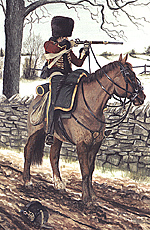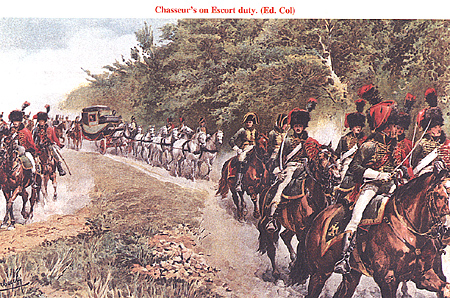'Decayed Splendor'
Chasseurs a Cheval
by Adrian George, UK
| |
The Chasseurs a Cheval, known as ‘The Invincibles’, were originally raised by Napoleon as the Guides de General Bonaparte in 1796 during his victorious campaign in Italy where they served primarily as an elite escort.
Large Chasseurs a Cheval Image (slow: 175K)
By 1801, the formation was raised to regimental status at a strength of two squadrons and as Napoleon was now First Consul, they were renamed the Chasseurs a Cheval de la Garde des Consuls.
In 1804 their title was again changed with the coming of the empire, to the Chasseurs a Cheval de la Garde Imperiale. By this time the regiment was four squadrons strong and along with the Grenadiers a Cheval, Gendarmes d’Elite and Marmalukes, constituted the cavalry of the Imperial Guard. They accompanied Napoleon on every campaign, taking part in, or being present at, the most famous engagements of the emperor’s early reign, Ulm, Austerlitz, Eylau, Friedland and Wagram. They served for a time in Spain before marching into Russia with the Grande Armee in 1812.
Following this disastrous expedition the depleted Chasseurs returned home with the remnants of the Guard at the end of that fateful year. By the early part of 1813 their strength was again raised to eight squadrons, of which five were ‘Old’ Guard and three, ‘Young’ Guard.
Napoleon was now desperately trying to hold on to Germany following the Russian disaster and the Chasseurs followed their emperor through the campaign, which ultimately ended at the bloody defeat of Leipzig.
My illustration is of a trooper of the Chasseurs a Cheval on campaign in February 1814. His uniform changed little over the years, but his somewhat scruffy appearance is a reflection of the decline in French fortunes after 1812. Although there were regulations as to uniform code, more often than not these were largely ignored in the field, mainly due to lack of replacement
garments than to any form of personal preference.
As an example, the Chasseur illustrated is wearing outdated breeches of green cloth, strengthened with leather. These were discontinued by around 1811 but owing to the dire re-supply situation, many older items remained in use until completely worn out.
His colpak is devoid of ornaments, which was the norm for field duties. Often a waterproof cover protected the prized bearskin from the elements. He is wearing the red pelisse as protection against the cold. For full dress and parade this would be hung from the left shoulder, in traditional Hussar fashion. The colour of the pelisse is somewhat duller than often depicted due to the rigours of campaign. Underneath his pelisse would be a green dolman tunic, fastened by eighteen buttons & toggles with gold braid. It had a green collar and scarlet cuffs.
The trooper is equipped with a Guard pattern light sabre, hung from the left side and a brace of pistols held in a pair of leather holsters, positioned at the front of the saddle, under the saddlecloth. Firing from the saddle in true light cavalry fashion, he is armed
with a 1796 pattern Hussar musketoon that was introduced to the Chasseurs in 1803.
The green saddlecloth is pinned back at the rear of the horse to protect it from the weather. The rear corners were embroidered with a gold imperial eagle motif. A bag of oats hangs behind the trooper, an essential item, as forage in this climate would have been sparse. Finally, this illustration of a veteran Chasseur displays an image of decayed splendour, a remnant of a proud past; in contrast, an infantry shako lies abandoned in the mud, discarded by a young conscript.
The French campaign of 1814 would see Napoleon at his best, winning a string of impressive victories with an inferior force, but the writing was on the wall. The Allies marched into Paris on March 31 st and a broken Napoleon abdicated at Fontainebleau on April 6th.
This was not to be the end for the Chasseurs, nor indeed Napoleon, that time would come on the field of Waterloo.
|

 His horse appears to be in good condition for the day. Being a member of the Guard, he would have been provided with better quality horses than those of the line cavalry. Following the grievous losses in Russia & Germany, the task of finding suitable remounts had become extremely difficult and with the loss of Germany in 1813 came the loss of good German breeding stock. The
only alternative was to press into service very young or less suitable horses. It must be remembered that to train a man to ride a horse is only half the problem. The new horses had to be trained as well. As a consequence, the French cavalry of 1813-14 was a shadow of its former self.
His horse appears to be in good condition for the day. Being a member of the Guard, he would have been provided with better quality horses than those of the line cavalry. Following the grievous losses in Russia & Germany, the task of finding suitable remounts had become extremely difficult and with the loss of Germany in 1813 came the loss of good German breeding stock. The
only alternative was to press into service very young or less suitable horses. It must be remembered that to train a man to ride a horse is only half the problem. The new horses had to be trained as well. As a consequence, the French cavalry of 1813-14 was a shadow of its former self.